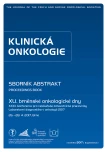Lactate Dehydrogenase – Old Tumour Marker in the Light of Current Knowledge and Preanalytic Conditions
Authors:
K. Greplová 1; I. Selingerová 2; D. Valík 1,2; K. Pilátová 1,2; M. Češková 1; L. Zdražilová Dubská 1,2
Authors‘ workplace:
Oddělení laboratorní medicíny, Masarykův onkologický ústav, Brno
1; RECAMO, Masarykův onkologický ústav, Brno
2
Published in:
Klin Onkol 2017; 30(Supplementum1): 156-158
Category:
Article
Overview
With the development and subsequent clinical applications of anticancer immuno-and angiomodulatory therapies and expanded knowledge on significance of tumor microenvironment for disease prognosis and treatment outcome, a classical blood analyte, lactate dehydrogenase (LDH), gains in importance as a tumor marker reflecting to some extent immunosupressive and angiogenic tumour milieu. Physical extravascular hemolysis due to complicated or inaccurate blood sampling interferes strongly with quantification of LDH in serum/plasma samples. Upon correlating circulating hemoglobin level with LDH catalytic activities in 99,937 plasma samples we quantified hemolysis interference with LDH plasma levels. An increment of LDH (μkat/l) caused by hemolysis is equal to 0.002 times circulating hemoglobin level (mg/l). Thus, hemolysis interference can be mathematically subtracted from measured LDH using a formula: [LDH (measured) (μkat/l) – 0.002 × circulating hemoglobin (mg/l) ]. In other words, each increment of hemolysis equal to 100 mg/l of circulating hemoglobin will result to LDH increase equal to 0.2 μkat/l. As one of the emerging predictors of treatment outcome, a cancer prognostic biomarker and dynamic tumor marker, serum/plasma LDH concentration needs to be interpreted with respect to reported hemolysis level. Also, for these purposes, quantitative determination of serum/plasma levels of free circulating hemoglobin has to be routinely performed.
Key words:
lactate dehydrogenase – hemolysis – preanalytical error
This work was supported by MEYS via NPS I for RECAMO2020 (LO1413).
The authors declare they have no potential conflicts of interest concerning drugs, products, or services used in the study.
The Editorial Board declares that the manuscript met the ICMJE recommendation for biomedical papers.
Submitted:
13. 3. 2017
Accepted:
26. 3. 2017
Sources
1. Valík D, Nekulová M, Zdražilová-Dubská L et al. Doporučení k využití nádorových markerů v klinické praxi. Klin Biochem Metab 2014; 22 (43): 22–39.
2. Mirrakhimov AE, Voore P, Khan M et al. Tumor lysis syndrome: a clinical review. World J Crit Care Med 2015; 4 (2): 130–138. doi: 10.5492/wjccm.v4.i2.130.
3. Zhuo Y, Lin L, Wei S et al. Pretreatment elevated serum lactate dehydrogenase as a significant prognostic factor in malignant mesothelioma: a meta-analysis. Medicine (Baltimore) 2016; 95 (52): e5706. doi: 10.1097/MD.0000000000005706.
4. Connell LC, Boucher TM, Chou JF et al. Relevance of CEA and LDH in relation to KRAS status in patients with unresectable colorectal liver metastases. J Surg Oncol 2016. doi: 10.1002/jso.24536.
5. Duffy MJ, Crown J. A personalized approach to cancer treatment: how biomarkers can help. Clin Chem 2008; 54 (11): 1770–1779. doi: 10.1373/clinchem.2008.110056.
6. Martens A, Wistuba-Hamprecht K, Geukes Foppen M et al. Baseline peripheral blood biomarkers associated with clinical outcome of advanced melanoma patients treated with ipilimumab. Clin Cancer Res 2016; 22 (12): 2908–2918. doi: 10.1158/1078-0432.CCR-15-2412.
7. Fědorová L, Poprach A, Lakomy R et al. Baseline peripheral blood biomarkers predict clinical outcome of advanced melanoma patients treated with ipilimumab: single institution real-life data experience. J Immunother Cancer 2017; abstract accepted.
8. Krajsova I, Arenberger P, Lakomy R et al. Long-term survival with ipilimumab: experience from a national expanded access program for patients with melanoma. Anticancer Res 2015; 35 (11): 6303–6310.
9. Dick J, Lang N, Slynko A et al. Use of LDH and autoimmune side effects to predict response to ipilimumab treatment. Immunotherapy 2016; 8 (9): 1033–1044. doi: 10.2217/imt-2016-0083.
10. Seifert H, Fisher R, Martin-Liberal J et al. Prognostic markers and tumour growth kinetics in melanoma patients progressing on vemurafenib. Melanoma Res 2016; 26 (2): 138–144. doi: 10.1097/CMR.0000000000000218.
11. Blank CU, Haanen JB, Ribas A et al. CANCER IMMUNOLOGY. The “cancer immunogram”. Science 2016; 352 (6286): 658–660. doi: 10.1126/science.aaf2834.
12. Seliger C, Leukel P, Moeckel S et al. Lactate-modulated induction of THBS-1 activates transforming growth factor (TGF) -beta2 and migration of glioma cells in vitro. PLoS One 2013; 8 (11): e78935. doi: 10.1371/journal.pone.0078935.
13. Ruffell B, DeNardo DG, Affara NI et al. Lymphocytes in cancer development: polarization towards pro-tumor immunity. Cytokine Growth Factor Rev 2010; 21 (1): 3–10. doi: 10.1016/j.cytogfr.2009.11.002.
14. Heming TA, Dave SK, Tuazon DM et al. Effects of extracellular pH on tumour necrosis factor-alpha production by resident alveolar macrophages. Clin Sci (Lond) 2001; 101 (3): 267–274.
15. Fox CJ, Hammerman PS, Thompson CB. Fuel feeds function: energy metabolism and the T-cell response. Nat Rev Immunol 2005; 5 (11): 844–852.
16. Warburg O. On the origin of cancer cells. Science 1956; 123 (3191): 309–314.
17. Langhammer S, Najjar M, Hess-Stumpp H et al. LDH-A influences hypoxia-inducible factor 1alpha (HIF1 alpha) and is critical for growth of HT29 colon carcinoma cells in vivo. Targeted oncology 2011; 6 (3): 155–162. doi: 10.1007/s11523-011-0184-7.
18. Scartozzi M, Giampieri R, Maccaroni E et al. Pre-treatment lactate dehydrogenase levels as predictor of efficacy of first-line bevacizumab-based therapy in metastatic colorectal cancer patients. Br J Cancer 2012; 106 (5): 799–804. doi: 10.1038/bjc.2012.17.
19. Passardi A, Scarpi E, Tamberi S et al. Impact of pre-treatment lactate dehydrogenase levels on prognosis and bevacizumab efficacy in patients with metastatic colorectal cancer. PLoS One 2015; 10 (8): e0134732. doi: 10.1371/journal.pone.0134732.
20. Marmorino F, Salvatore L, Barbara C et al. Serum LDH predicts benefit from bevacizumab beyond progression in metastatic colorectal cancer. Br J Cancer 2017; 116 (3): 318–323. doi: 10.1038/bjc.2016.413.
Labels
Paediatric clinical oncology Surgery Clinical oncologyArticle was published in
Clinical Oncology

2017 Issue Supplementum1
Most read in this issue
- Ascites May Provide Useful Information for Diagnosis of Ovarian Cancer
- Lactate Dehydrogenase – Old Tumour Marker in the Light of Current Knowledge and Preanalytic Conditions
- Molecular Pathology of Colorectal Cancer, Microsatellite Instability – the Detection, the Relationship to the Pathophysiology and Prognosis
- Circulating Myeloid Suppressor Cells and Their Role in Tumour Immunology
